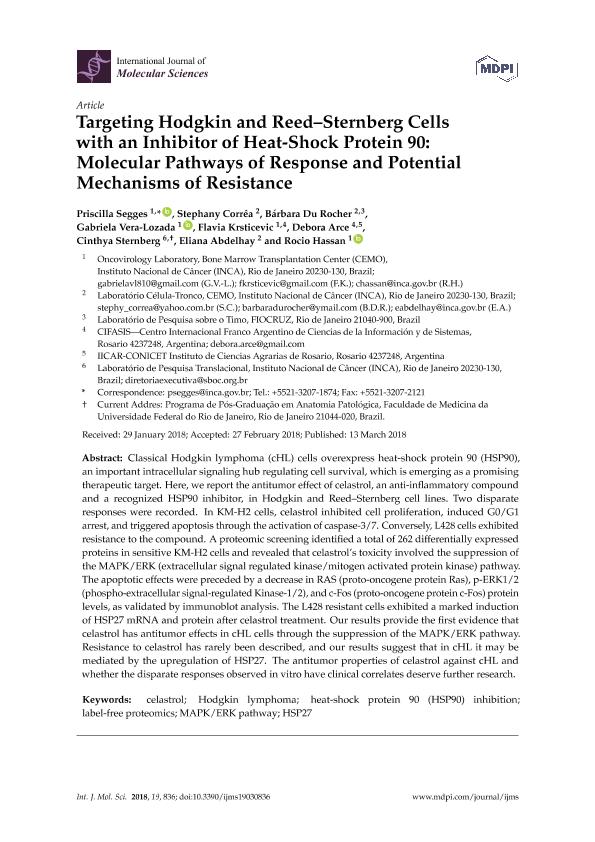Artículo
Targeting hodgkin and reed–sternberg cells with an inhibitor of heat-shock protein 90: Molecular pathways of response and potential mechanisms of resistance
Segges, Priscilla; Corrêa, Stephany; Du Rocher, Bárbara; Vera Lozada, Gabriela; Krsticevic, Flavia Jorgelina ; Arce, Debora Pamela
; Arce, Debora Pamela ; Sternberg, Cinthya; Abdelhay, Eliana; Hassan, Rocio
; Sternberg, Cinthya; Abdelhay, Eliana; Hassan, Rocio
 ; Arce, Debora Pamela
; Arce, Debora Pamela ; Sternberg, Cinthya; Abdelhay, Eliana; Hassan, Rocio
; Sternberg, Cinthya; Abdelhay, Eliana; Hassan, Rocio
Fecha de publicación:
03/2018
Editorial:
Molecular Diversity Preservation International
Revista:
International Journal of Molecular Sciences
ISSN:
1422-0067
Idioma:
Inglés
Tipo de recurso:
Artículo publicado
Clasificación temática:
Resumen
Classical Hodgkin lymphoma (cHL) cells overexpress heat-shock protein 90 (HSP90), an important intracellular signaling hub regulating cell survival, which is emerging as a promising therapeutic target. Here, we report the antitumor effect of celastrol, an anti-inflammatory compound and a recognized HSP90 inhibitor, in Hodgkin and Reed-Sternberg cell lines. Two disparate responses were recorded. In KM-H2 cells, celastrol inhibited cell proliferation, induced G0/G1 arrest, and triggered apoptosis through the activation of caspase-3/7. Conversely, L428 cells exhibited resistance to the compound. A proteomic screening identified a total of 262 differentially expressed proteins in sensitive KM-H2 cells and revealed that celastrol’s toxicity involved the suppression of the MAPK/ERK (extracellular signal regulated kinase/mitogen activated protein kinase) pathway. The apoptotic effects were preceded by a decrease in RAS (proto-oncogene protein Ras), p-ERK1/2 (phospho-extracellular signal-regulated Kinase-1/2), and c-Fos (proto-oncogene protein c-Fos) protein levels, as validated by immunoblot analysis. The L428 resistant cells exhibited a marked induction of HSP27 mRNA and protein after celastrol treatment. Our results provide the first evidence that celastrol has antitumor effects in cHL cells through the suppression of the MAPK/ERK pathway. Resistance to celastrol has rarely been described, and our results suggest that in cHL it may be mediated by the upregulation of HSP27. The antitumor properties of celastrol against cHL and whether the disparate responses observed in vitro have clinical correlates deserve further research.
Archivos asociados
Licencia
Identificadores
Colecciones
Articulos(IICAR)
Articulos de INST. DE INVESTIGACIONES EN CIENCIAS AGRARIAS DE ROSARIO
Articulos de INST. DE INVESTIGACIONES EN CIENCIAS AGRARIAS DE ROSARIO
Citación
Segges, Priscilla; Corrêa, Stephany; Du Rocher, Bárbara; Vera Lozada, Gabriela; Krsticevic, Flavia Jorgelina; et al.; Targeting hodgkin and reed–sternberg cells with an inhibitor of heat-shock protein 90: Molecular pathways of response and potential mechanisms of resistance; Molecular Diversity Preservation International; International Journal of Molecular Sciences; 19; 3; 3-2018; 1-14
Compartir
Altmétricas



